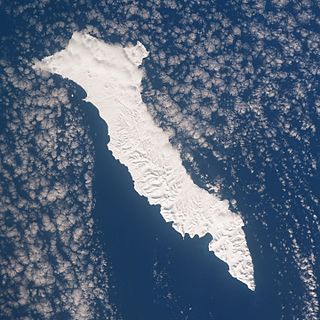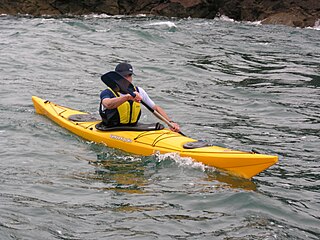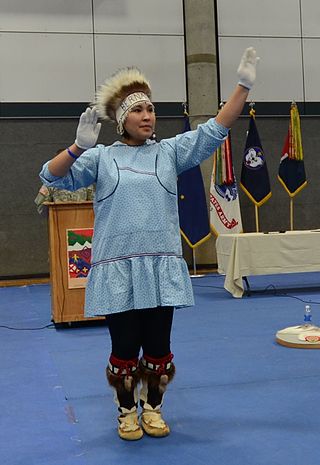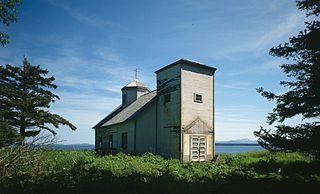
The Aleuts are the Indigenous people of the Aleutian Islands, which are located between the North Pacific Ocean and the Bering Sea. Both the Aleut people and the islands are politically divided between the US state of Alaska and the Russian administrative division of Kamchatka Krai. This group is also known as the Unangax̂ (Oo-NUNG-ukh) in Unangam Tunuu, the Aleut language.

A kayak is a small, narrow human-powered watercraft typically propelled by means of a long, double-bladed paddle. The word kayak originates from the Greenlandic word qajaq.

Bering Island is located off the Kamchatka Peninsula in the Bering Sea.

Sand Point, also known as Popof Island, is a city in Aleutians East Borough, Alaska, United States. At the 2010 census the population was 976, up from 952 in 2000, but by the 2020 Census this had reduced to 578. It is on northwestern Popof Island, one of the Shumagin Islands, off the Alaska Peninsula. It is the borough seat of Aleutians East Borough, and is near the entrance to the Bering Sea.

A sea kayak or touring kayak is a kayak used for the sport of paddling on open waters of lakes, bays, and oceans. Sea kayaks are seaworthy small boats with a covered deck and the ability to incorporate a spray deck. They trade off the manoeuvrability of whitewater kayaks for higher cruising speed, cargo capacity, ease of straight-line paddling (tracking), and comfort for long journeys.
A folding kayak is a direct descendant of the original Inuit kayak made of animal skins stretched over frames made from wood and bones. A modern folder has a collapsible frame made of some combination of wood, aluminium and plastic, and a skin made of a tough fabric with a waterproof coating. Many have integral air chambers inside the hull, making them virtually unsinkable.

Alaska Natives are the Indigenous peoples of Alaska and include Iñupiat, Yupik, Aleut, Eyak, Tlingit, Haida, Tsimshian, and a number of Northern Athabaskan cultures. They are often defined by their language groups. Many Alaska Natives are enrolled in federally recognized Alaska Native tribal entities, who in turn belong to 13 Alaska Native Regional Corporations, who administer land and financial claims.

Afognak (; also Agw'aneq in Alutiiq was an Alutiiq village on the island of Afognak in Kodiak Island Borough, Alaska, United States. It was located on Afognak Bay on the southwest coast of the island, three miles north of Kodiak Island. The site is now within the CDP of Aleneva.

The umiak, umialak, umiaq, umiac, oomiac, oomiak, ongiuk, or anyak is a type of open skin boat, used by both Yupik and Inuit, and was originally found in all coastal areas from Siberia to Greenland. First used in Thule times, it has traditionally been used in summer, for moving people and possessions to seasonal hunting grounds, and for hunting whales and walrus. Although the umiak was usually propelled by oars (women) or paddles (men), sails—sometimes made from seal intestines—were also used, and, in the 20th century, outboard motors. Because the umiak has no keel, the sails cannot be used for tacking.

George Dyson is an American non-fiction author and historian of technology whose publications broadly cover the evolution of technology in relation to the physical environment and the direction of society. He has written on a wide range of topics, including the history of computing, the development of algorithms and intelligence, communications systems, space exploration, and the design of watercraft.

Prehistoric Alaska begins with Paleolithic people moving into northwestern North America sometime between 40,000 and 15,000 years ago across the Bering Land Bridge in western Alaska; a date less than 20,000 years ago is most likely. They found their passage blocked by a huge sheet of ice until a temporary recession in the Wisconsin glaciation opened up an ice-free corridor through northwestern Canada, possibly allowing bands to fan out throughout the rest of the continent. Eventually, Alaska became populated by the Inuit and a variety of Native American groups. Trade with both Asia and southern tribes was active even before the advent of Europeans.
The Aleutian Tradition began around 2500 BC and ended in AD 1800. Aleutian artifacts are made out of chopped stone, unlike the more common slate tools. Objects were traditionally made using a concept called core and flake that uses bifacially carved projectile points. The Aleutian people lived in semi-subterranean winter houses made from driftwood, whale bone, and peat. They used kayaks, atlatls and harpoons to kill sea mammals for sustenance. Around AD 1150 Aleutian houses increased considerably in size. Food was stored in special chambers inside the house and weaponry was becoming more common around these sites. The sustenance pattern changed from relying on sea mammals to eating mostly salmon. Long-distance trade also started increasing community with other local groups.

A barabara or barabora (Russian); ulax̂, ulaagamax, ulaq, or ulas (plural) (Aleut); and ciqlluaq were the traditional, main or communal dwelling used by the Alutiiq people and Aleuts, the indigenous people of the Aleutian Islands. They lay partially underground like an earth lodge or pit-house, and most of the house was excavated from the dirt so as to withstand the high forces of wind in the Aleutian chain of islands. Barabaras are no longer used, as present-day Aleuts live in modern houses and apartment buildings.
The Aleutian World War II National Historic Area is a U.S. National Historic Site on Amaknak Island in the Aleutian Island Chain of Alaska. It offers visitors a glimpse of both natural and cultural history, and traces the historic footprints of the U.S. Army Base, Fort Schwatka, located at the Ulakta Head on Mount Ballyhoo. The fort, 800 miles west of Anchorage, the nearest large urban center, was one of four coastal defense posts built to protect Dutch Harbor during World War II; Fort Schwatka is also the highest coastal battery ever constructed in the United States. The other Army coastal defense facilities were Fort Mears, Fort Learnard, and Fort Brumback. Engineers designed the concrete observation posts and command stations to withstand earthquakes and 100 mph winds. Although today, many of the bunkers and wooden structures of Fort Schwatka have collapsed, the gun mounts and lookouts are among the most intact in the country.

Sergie Sovoroff was an Unangax̂ educational leader. He was born on Umnak Island in the Unangax̂ village of Nikolski in 1902. Sovoroff was born only nine years before the United States government outlawed sea otter hunting.

Andrew Gronholdt was a famous Aleut from Sand Point, Alaska, in the Shumagin Islands south of the lower Alaska Peninsula and became famous for rejuvenating the ancient Unangan art of carving hunting hats called chagudax. In January 2012, a book was published posthumously by Gronholdt titled "Chagudax: A Small Window into the Life of An Aleut Bentwood Hat Carver" Gronholdt's woodworking techniques, wood steaming and bending methods, and instructional design methodologies were legendary.

The Aleutian Islands, also called the Aleut Islands or Aleutic Islands and known before 1867 as the Catherine Archipelago, are a chain of 14 large volcanic islands and 55 smaller islands. Most of the Aleutian Islands belong to the U.S. state of Alaska, but some belong to the Russian federal subject of Kamchatka Krai. They form part of the Aleutian Arc in the Northern Pacific Ocean, occupying a land area of 6,821 sq mi (17,666 km2) and extending about 1,200 mi (1,900 km) westward from the Alaska Peninsula toward the Kamchatka Peninsula in Russia, and act as a border between the Bering Sea to the north and the Pacific Ocean to the south. Crossing longitude 180°, at which point east and west longitude end, the archipelago contains both the westernmost part of the United States by longitude and the easternmost by longitude. The westernmost U.S. island in real terms, however, is Attu Island, west of which runs the International Date Line. While nearly all the archipelago is part of Alaska and is usually considered as being in the "Alaskan Bush", at the extreme western end, the small, geologically related Commander Islands belong to Russia.

Yup'ik clothing refers to the traditional Eskimo-style clothing worn by the Yupik people of southwestern Alaska.

Unangan hunting headgear are wooden hats associated with the Unangan or Unangas, the Indigenous peoples of what are currently known as the Aleutian Islands.
Agdaagux Tribe of King CoveAlaska is a federally recognized tribe based in Belkofski, Alaska. Population is found to be 845 people, 170 households, and 116 families in King Cove as of 2022. The tribe is descended from both Unangax and non-Native people.




















